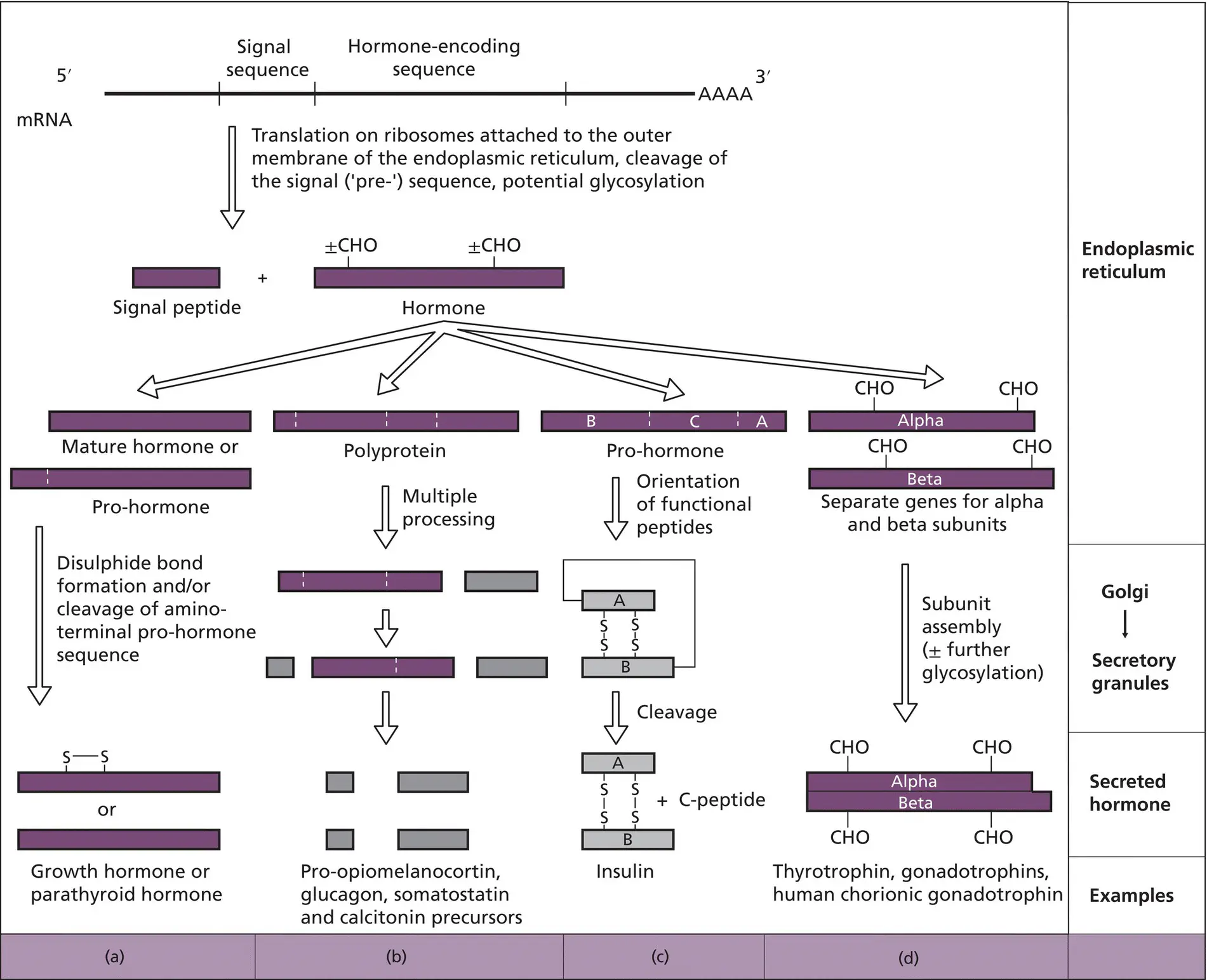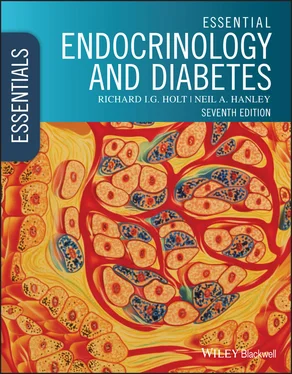1 ...8 9 10 12 13 14 ...24 mRNA is transported to the ribosomes, where protein synthesis occurs by ‘translation’ ( Figure 2.3a). The ribosomes are attached to the outside of the endoplasmic reticulum (ER), leading to the description of ‘rough ER’. The ribosome is an RNA–protein complex that reads the mRNA sequence in groups of three nucleotides, called a codon. Each codon represents an amino acid. The start codon is the sequence of A–U–G nucleotides (corresponding to ATG in the genomic DNA) and specifies the amino acid methionine ( Figure 2.2). From this point onwards, translation continues until a ‘stop’ codon is encountered (UAA, UGA or UAG).
By understanding these normal events of gene transcription and protein translation, it becomes possible to appreciate how mutations (sequence errors) in the genomic DNA lead to a miscoded, and consequently malfunctional, protein ( Box 2.2). An entire gene may be missing (‘deleted’) or duplicated. An erroneous base pair in an enhancer or the promoter region may impair binding of a critical transcription factor and lessen a gene’s expression. A similar error in a coding exon might translate a different amino acid or even miscode a premature stop codon. Small deletions or insertions of one or two base pairs throw the whole triplet code out of frame. A mutation at the boundary between an intron and an exon can corrupt splicing so that the intron is included in the mature mRNA. All of these genetic events can affect endocrinology either as developmental disorders when that the fault is likely to be present in all or many of the body’s cells, or as acquired change later in life, potentially predisposing to the formation of an endocrine tumour ( Chapter 10).

Figure 2.3 (a) Peptide hormone‐synthesizing and (b) steroid hormone‐synthesizing cells. In (b), cholesterol enters the cell via the low‐density lipoprotein receptor which is internalized.
Box 2.2Genetic, genomic and epigenetic abnormalities that can result in endocrinopathy
Abnormalities in DNA (genetic)
Base substitution – swapping different nucleotides
Insertion or deletion – alters frame if exonic and not a multiple of three
Chromosomal abnormalities (genomic)
Numerical – loss of an X chromosome as in Turner syndrome (45,XO)
Structural:Inversion – region of a chromosome is turned upside downTranslocation – regions swapped between chromosomesDuplication – region of a chromosome is present twiceDeletion – region of a chromosome is excised and lost
Imprinting abnormalities (epigenetic)
Methylation – altered methylation changing local gene expression, such as Beckwith–Wiedemann syndrome with neonatal hypoglycaemia or transient neonatal diabetes mellitus associated with over‐expression of the gene called PLAGL1
Structural chromosomal abnormalities (above) can also cause imprinting errors
Post‐translational modification of peptides
Some polypeptides can function as hormones after little more than removal of the starting methionine, e.g. thyrotrophin‐releasing hormone (TRH), which comprises only three amino acids. Larger peptides can fold into three‐dimensional structures, which may contain helical or pleated domains. These shapes provide stability and affect how one protein interacts with another (e.g. how a hormone might bind to its receptor).
For hormones that require secretion out of the cell, additional modifications are important ( Figure 2.4). The precursor peptide, called a pre‐prohormone, carries a lipophilic signal peptide at the amino terminus. This sequence is recognized by channel proteins so that the immature peptide can cross the ER membrane. Once inside the ER, the signal peptide is excised in preparation for other post‐translational changes ( Figure 2.4a–d).

Figure 2.4 Potential post‐translational modifications of peptide hormones. Four types are shown. (a) Simple changes such as removal of the amino‐terminal ‘pro‐’ extension prior to secretion (e.g. parathyroid hormone) or the addition of intra‐chain disulphide bonds (e.g. growth hormone). (b) Multiple processing of a ‘polyprotein’ into a number of different peptide hormones (e.g. pro‐opiomelanocortin can give rise to adrenocorticotrophic hormone plus melanocyte‐stimulating hormone and β‐endorphin). (c) Synthesis of insulin requires folding of the peptide and the formation of disulphide bonds. The active molecule is created by hydrolytic removal of a connecting (C)‐peptide so that proinsulin gives rise to insulin plus C‐peptide in equimolar proportion. (d) Synthesis of larger protein hormones (e.g. thyroid‐stimulating hormone, luteinizing hormone, follicle‐stimulating hormone and human chorionic gonadotrophin) from two separate peptides that complex together. The four hormones share the same α‐subunit with a hormone‐specific β‐subunit.
Disulphide bridges are formed in certain proteins (e.g. growth hormone or insulin; Figure 2.4a and c). Certain carbohydrates may be added to form glycoproteins ( Figure 2.4d). Some prohormones (e.g. pro‐opiomelanocortin and pro‐glucagon) are processed into several final products, whereas others are assembled as a combination of distinct peptide chains, each synthesized from different genes, e.g. thyroid‐stimulating hormone (TSH) or luteinizing hormone (LH).
The complete protein is then packaged into membrane‐bound vesicles, which may contain specific ‘endopeptidases’. These enzymes are responsible for final hormone activation by cleaving off the ‘pro‐’ portion, as occurs with the release of insulin and its by‐product, C‐peptide ( Figure 2.4c). Such post‐translational modifications are essential stages in hormone synthesis ( Box 2.3).
Box 2.3Role of post‐translational modifications
Post‐translational modifications mean:
Great diversity of hormone action can be generated from a more limited range of protein‐coding genes
The synthesizing cell is protected from being overwhelmed by its own hormone action
Storage and secretion of peptide hormones
Newly synthesized peptide hormone is stored within the cell in small vesicles or secretory granules. Movement of these vesicles to a position near the cell membrane is influenced by two types of filamentous structure: microtubules and microfilaments ( Figure 2.3a). Consequently, the secretion of stored hormone tends to be rapid but only occurs after appropriate stimulation of the cell. Whether this is hormonal, neuronal or nutritional, it usually involves a change in cell membrane permeability to calcium ions. These divalent metal ions are required for interaction between the vesicle and plasma membrane, and for the activation of enzymes, microfilaments and microtubules. The secretory process is called ‘exocytosis’ ( Figure 2.3a). The membrane of the storage granule fuses with the cell membrane at the same time as vesicular endopeptidases are activated. The active hormone is expelled into the extracellular space from where it enters the bloodstream. The vesicle membrane is then recycled within the cell.
Synthesizing a hormone derived from amino acids or cholesterol
In addition to peptides or proteins, hormones can also be synthesized by sequential enzymatic modification of either the amino acids tyrosine and tryptophan, or cholesterol.
Читать дальше














